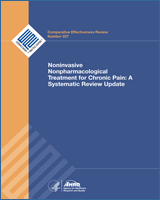From: Results

NCBI Bookshelf. A service of the National Library of Medicine, National Institutes of Health.
| Author, Year, Followup,a Pain Duration, Study Quality | Intervention | Population | Function and Pain Outcomes | Other Outcomes |
|---|---|---|---|---|
Pach, 2018183 1 and 3 months Duration of pain: mean 11.2 to 11.5 years Fair [New trial] | A. Tunia massage (n=46) Two 30-minute sessions/week for 3 weeks (6 sessions total). Authors report high adherence but data is not provided. B. No intervention waitlist (n=46) | A vs. B Age: 46 vs. 45 years Female: 89.1% vs. 84.8% Baseline NDI (0-50): 45.5 vs. 46.5 Baseline NPDS (0-100): 42.7 vs. 42.7 Baseline pain during previous 7 days (0-100 VAS): 55.8 vs. 59.5 | A vs. B 3 months NDI: 36.6 (95% CI 33.5 to 39.6) vs. 46.1 (95% CI 42.9 to 49.3), adjusted difference −9.6 (95% CI −14.0 to −5.1) NPDS: 30.2 (95% CI 25.8 to 34.6) vs. 42.3 (95% CI 37.7 to 46.8), adjusted difference −12.1 (95% CI −18.4 to −5.8) Mean VAS score during previous 7 days: 30.1 (95% CI 23.8 to 36.4) vs. 48.1 (95% CI 41.5 to 54.6), adjusted difference −17.9 (95% CI −27.1 to −8.8); | A vs. B 3 months SF-12 Physical health (0-100): 48.1 (95% CI 45.8 to 50.3) vs. 42.4 (95% CI 40.1 to 44.7), adjusted difference 5.6 (95% CI 2.4 to 8.9) SF-12 Mental health (0-100): 48.3 (95% CI 45.4 to 51.1) vs. 45.7 (95% CI 42.8 to 48.5), adjusted difference 2.6 (95% CI −1.4 to 6.6) Proportion of patients using medication for neck pain during the previous 4 weeks: 0.4 (95% CI 0.2 to 0.6) vs. 0.5 (95% CI 0.3 to 0.7), adjusted difference −0.1 (95% CI −0.4 to 0.1) |
Rudolfsson, 2014181 6 months Duration of pain: median 84 to 123 months Fair | A. Massage, classical (n=36): upper body including the back, neck and shoulders. B. Neck coordination exercise (n=36): performed with a newly developed training device designed to improve the fine movement control of the cervical spine. C. Strength training (n=36): isometric and dynamic exercises targeting the neck and shoulder regions. All 3 interventions consisted of 22 individually supervised single treatment sessions, 30 min each, distributed over 11 weeks | A vs. B vs. C Age: 51 vs. 52 vs. 51 years Female: 100% vs. 100% vs. 100% Baseline pain (0-10 NRS), 5 vs. 6 vs. 6 (median) Baseline NDI: 26 vs. 29 vs. 31 SF-36 PCS (0-100): 43 vs. 39 vs. 39 (median) SF-36 MCS (0-100): 49 vs. 52 vs. 47 (median) | A vs. B: 6 months Pain NRS (0-10): 4.0 vs. 3.8, difference 0.2 (95% CI −0.8 to 1.2) A vs. C: 6 months Pain NRS (0-10): No data given at 6 month, however, authors state no difference among A, B or C. | NR |
Sherman, 2009182 2.5 and 6.5 months Duration of pain >1 year: 81% Fair | A. Massage (n=32): Swedish and clinical techniques and self-care recommendations; 10 massage treatments over a 10-week period B. Self-care book: (n=32) information on potential causes of neck pain, neck-related headaches, whiplash, recommended strengthening exercises, body mechanics and posture, conventional treatment, complementary therapies for neck pain, and first aid for intermittent flare-ups. | A vs. B Age: 47 vs. 46 years Female: 69% vs. 69% White: 87% vs. 81% Smoker: 9% vs. 6% Pain lasted > 1 year: 81% vs. 81% Baseline NDI (0-50): 14.2 vs. 14.2S | A vs. B 2.5 months NDI, % ≥5 points: 39% vs. 14%, RR 2.7 (95% CI 0.99 to 7.5) NDI (0-50): difference −2.3 (95% CI −4.7 to 0.15) 6.5 months | A vs. B 2.5 months Bothersome score (0-10): difference −1.2 (95% CI −2.5 to 0.1) Bothersome improvement ≥30%: 55% vs. 25%, RR 2.1 (95% CI 1.04 to 4.2) SF-36 PCS (0-100): 52.8 vs. 53.3, p=0.982 SF-36 MCS (0-100): 45.9 vs. 45.3, p=0.444 6.5 months Bothersome score: difference −0.14 (95% CI −1.5 to 1.2) Bothersome improvement ≥30%: 43% vs. 39%, RR 1.1 (95% CI 0.6 to 2.0) SF-36 PCS and MCS: data not given, no statistical difference Medication use: No change in group A, 14% increase in group B |
Unless otherwise noted, followup time is calculated from the end of the treatment period.
From: Results

NCBI Bookshelf. A service of the National Library of Medicine, National Institutes of Health.